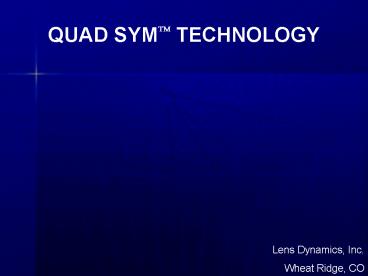QUAD SYM TECHNOLOGY - PowerPoint PPT Presentation
1 / 16
Title:
QUAD SYM TECHNOLOGY
Description:
Larger diameters cannot be lathed much steeper B.C. than 5.80 mm. 2.0 mm of spread in B.C.s is maximum. ... i.e. Quad 3 is 40.00 D. 1 D. flatter = 39.00 D./ 8.65 mm. ... – PowerPoint PPT presentation
Number of Views:61
Avg rating:3.0/5.0
Title: QUAD SYM TECHNOLOGY
1
QUAD SYM? TECHNOLOGY
Lens Dynamics, Inc. Wheat Ridge, CO
2
QUAD SYM? TECHNOLOGY
- Based on Quadrant Specific Technology.
- Can be the entire B.C. radii in one quadrant or
just in the edge. - Is it the full piece of the pie or just the
crust?
3
DEFINE QUADRANTS
- Quadrant (Quad) 1 is from 130 to 430
- Quadrant (Quad) 2 is from 1030 to 130
- Quadrant (Quad) 3 is from 730 to 1030
- Quadrant (Quad) 4 is from 430 to 730
4
QUAD SYM? B.C. DESIGN
- Entire piece of the pie or quadrant.
- Allows the lens to have up to 4 different base
curves. - The lathe cuts a proper front radii to achieve
correct power.
5
QUAD SYM? P.C. DESIGN
- Just the edge or crust.
- Allows for different edge lifts in all 4
quadrants. - Helpful with edge standoff at 6 oclock.
- Several steps flatter or steeper from Standard
edge lift available.
6
- Quad Sym? B.C. and Quad Sym? P.C. designs can be
combined when needed.
7
HOW TO FIT
- Start with a spherical large trial lens Dyna
Intra-Limbal?. - Align at least one quadrant and do over
refraction. - Document the fluorescein pattern in other
quadrants. - i.e. Are the other quadrants pooled or touching?
- Provide topography.
- Lab will design other quadrants based on this
information
8
LATHE LIMITATIONS
- Larger diameters cannot be lathed much steeper
B.C. than 5.80 mm. - 2.0 mm of spread in B.C.s is maximum.
- Some lenses will need to be smaller to achieve
needed B.C.s. - i.e. 10.2 mm to 10.8 mm diameters
9
FLUORESCEIN EVALUATION
10
TOPOGRAPHY
- Quad 1 and 4 are steep at 50.00 D. or 6.75 mm.
- Quad 2 is moderate at 47.00 D. or 7.18 mm.
- Quad 3 is Flat at 40.00 D. or 8.44 mm.
11
HOW TO FIT
- Start with 1 D. flatter than one quadrant.
- i.e. Quad 3 is 40.00 D. 1 D. flatter 39.00
D./ 8.65 mm. - Quad 1 is 49.00 D. 1 D. flatter 48.00 D./
6.89 mm. - Get best alignment in a quadrant. The other
quadrants will be steepened or flattened per
topography by the lab. - Note the pooling or touch in the other quadrants.
Regular Dyna Intra-Limbal on eye
- Do over refraction.
12
Sphere on eye
Quad-Sym on eye
13
WHAT THE ORDER LOOKS LIKE
- Base Curve Quad Sym? B.C. design.
- Q1 4 49.00, Q2 46.00, Q3 39.00
- Power From trial fit 3900, Total Power -6.00
- Diameter 11.2 with 9.4 OZ
- Edge Standard Lift
14
QUAD SYM? P.C. DESIGN
- Trial fit with large diameter lens Dyna
Intra-Limbal? - Fit with standard spherical B.C. but fitter sees
edge problems. - Increase or decrease edge lift in each quadrant
as needed. - i.e. Trial of 7.50, -3.00, 11.2/9.4 fits well
except there is pinch off at 1200 oclock and
standoff at 600 oclock. - Order 7.50, -3.00, 11.2 / 9.4, Quad Sym? P.C. of
Quad 1 3 Standard, Quad 2 2 steps Flat,
Quad 4 4 steps Steep.
15
QUAD SYM? P.C. DESIGN
Rx Lens
Trial Lens
B.C. 7.50 Pwr -3.00 Dia 11.2 with 9.4 OZ Edge
Lift Standard
B.C. 7.50 Pwr -3.00 Dia. 11.2 with 9.4 OZ Edge
Lift Q1 3 Standard Q2 2 steps Flat, Q4 4
steps steep
16
- Questions?
Lens Dynamics, Inc.































